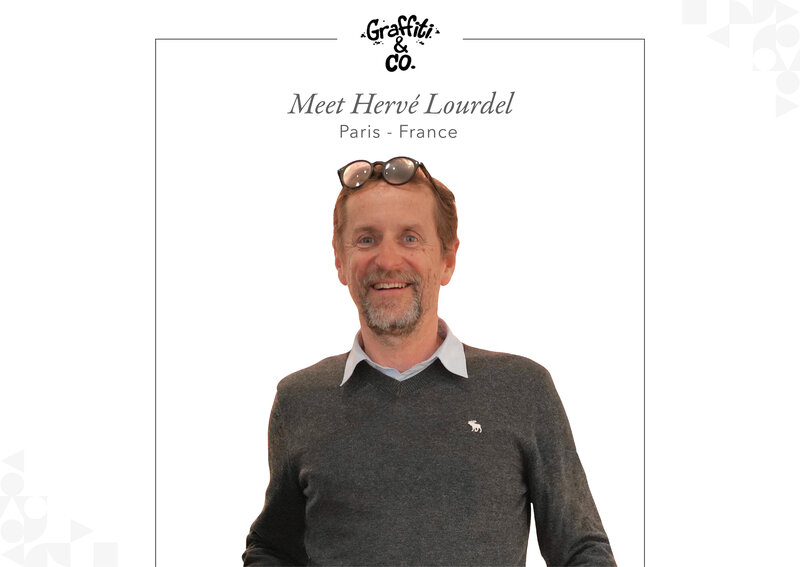We use cookies to make your experience better. To comply with the new e-Privacy directive, we need to ask for your consent to set the cookies. Learn more.

- 01/20/2023
Muse Square: Can you tell us the story of your gallery?
Hervé Lourdel: We are a very young gallery, we opened our gallery in November 2021. We specialize in the American Graffiti of the 80’s.
When I decided to open my gallery, I was a graffiti collector. I was also an art dealer from 1989 to 2008. I used to sell classical artworks of the 19th century. Later on, I started to sell artworks of the 60’s and more contemporary pieces. At a certain point of time, I decided to put my art experience at the service of art collectors, and decided to open Graffiti and Co.
I have always bought and resold artworks, and when you buy, you let time pass. There is a logic of appreciation behind it: In fact, in the 90’s people used to appreciate the “space” as there was less circulation of information. So, the “place” where your painting was had a value.
Today, it’s true that information circulates much more and much faster. The notion of space is no longer valuable. The only thing that still has value is time. Indeed, we buy artworks with the vision of what will happen in the future. So, the added value these days is based on the notion of time.
Muse Square: Can you present the contemporary graffiti art scene and the artists you chose to work with?
Hervé Lourdel: The graffiti art movement is considered the last art movement since the year 2000. The American graffiti consists of about fifteen artists who started with train wagons in the 80’s. I know some of these pioneer graffiti artists personally, I am still working with some until this date. We became friends and I visit them often when I am in New York.
On a separate note, today there is a discrimination in terms of revenues for the pioneer of this movements with whom I work. Many young artists are generating more money because they communicate well on social media, while the initiators of this movement who started working two or three decades earlier have much less visibility, and hence make less money. So, here, it’s my job to set the record straight.
Muse Square: How did the Graffiti movement transitioned from train art to canva art?
Hervé Lourdel: There were two visionaries who facilitated this transition. The first graffiti exhibition was done by Hugo Martinez who rented a space in 1973 and 1974 to exhibit the work of the artists. At that time graffiti artists where not very famous for train wagons painting, this trend was most noticeable in the 80’s. Another visionary rented a studio in the 80’s in Manhattan to gather the graffiti artists to work on canva.
“There are fewer complications and more flexibility when you collaborate with others, I love working with my peers, it’s in my DNA.”
Muse Square: Have you previously collaborated with other galleries?
Hervé Lourdel: previously, I used to work at the Clignancourt flea market where eighty percent of the transactions were done collaboratively. There are fewer complications and more flexibility when you collaborate with others, I love working with my peers, it’s in my DNA.
Muse Square: Can you tell us more about the collaboration process between you and your peers?
Hervé Lourdel: Collaborating was very common in the 90’s, it was a habit as there was less information, therefore the price of the painting was more fluctuating based on where it was located. We had the habit of working with each other voluntarily or based on commission.
Today with the massive spread of information, there is less fluidity in the market, there are fewer transactions. I remember we used to grab a painting from a gallery, meet a dealer on the sidewalk and sell the artwork. The dealer used to take the painting and pay me the week after. This kind of trust no longer exists today.
Muse Square: Do you think that collaborating with gallery peers could solve the problem of isolation that many galleries face?
Hervé Lourdel: Unfortunately, you talk about something that touches me: loneliness. As I mentioned, in the present day, there is no more trust and no more collaboration. Gallerist are afraid you steal their clients and artists. You always need to be careful and keep book records.
Currently, I see a lot of galleries that are suffering, with people who don’t necessarily come from the art world. They just buy a space and a computer, they know three artists, and then claim to be gallerists.
In the 90’s, we had a learning curve to become gallerist, most galleries were part of art associations. There was more trust and ethics in the way we used to work and most importantly, we used to collaborate.
RECOMMENDED TOPICS
We use cookies to make your experience better. To comply with the new e-Privacy directive, we need to ask for your consent to set the cookies. Learn more.
